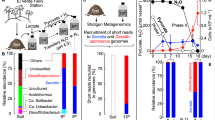Abstract
Xylose is a major constituent of hardwood and agricultural residues. Its effective utilization is essential to the economic practicability of any process seeking to use these materials for chemical production. A yeast, Pachysolen tannophilus, has been shown to ferment xylose to ethanol, acetic acid and xylitol, but the rate is slow and yields of ethanol are low. Growth on NO3− is known to stimulate synthesis of pentosephosphate pathway enzymes, and these studies showed that NO3− stimulates the aerobic production of ethanol from xylose by Pachysolen. Anaerobic production of ethanol, however, was inhibited by NO3−. Inhibition required induction by growth on NO3−, and inhibition was repressed by NH4+, indicating that nitrate reductase might be involved. Growth rates and product ratios were affected significantly by the nitrogen source used. These results suggest that selection for NO3− utilization could be a useful screen in the development of yeast strains with improved ability to ferment xylose.
*Maintained in cooperation with the University of Wiscosin, Madison, Wis.
This is a preview of subscription content, access via your institution
Access options
Subscribe to this journal
Receive 12 print issues and online access
$209.00 per year
only $17.42 per issue
Buy this article
- Purchase on Springer Link
- Instant access to full article PDF
Prices may be subject to local taxes which are calculated during checkout
Similar content being viewed by others
References
Schneider, H., Wang, P.Y., Chang, Y.K. and Maleszka, R. 1981. Conversion of D-xylose into ethanol by the yeast Pachysolen tannophilus. Biotechnol. Lett. 3: 89–92.
Slininger, P.J., Bothast, R.J., van Cawenberge, J.E. and Kurtzman, C.P. 1982. Conversion of D-xylose to ethanol by the yeast Pachysolentannophilus. Biotechnol. Bioeng. 24: 371–384.
Gong, C.-S., McCracken, L.D. and Tsao, G.T. 1981. Direct fermentation of D-xylose to ethanol by a xylose-fermenting yeast mutant, Candida sp. XF 217. Biotechnol. Lett. 3: 245–250.
Jeffries, T.W. 1981. Conversion of xylose to ethanol under aerobic conditions by Candida tropicalis. Biotechnol. Lett. 3: 213–218.
Jeffries, T.W. 1982. A comparison of Candida tropicalis and Pachysolen tannophilus for conversion of xylose to ethanol. Biotechnol. Bioeng. Symp. 12: 103–110.
Margaritis, A. and Bajpai, P. 1982. Direct fermentation of D-xylose to ethanol by Kluyveromyces marxianus strains. Appl. Environ. Microbiol. 44: 1039–1041.
Barnett, J.A. 1976. The utilization of sugars by yeasts. Adv. Carbohyd. Chem. Biochem. 32: 125–234.
Scheffers, W.A. and Wiken, T.O. 1969. The Custers effect (negative Pasteur effect) as a diagnostic criterion for the genus Brettanomyces. Antonie van Leeuwenhoek 35: A31–32.
Chiang, C. and Knight, S.G. 1960. Metabolism of D-xylose by moulds. Nature 188: 79–81.
Smiley, K.L. and Bolen, P.L. 1982. Demonstration of D-xylose reductase and D-xylitol dehydrogenase in Pachysolen tannophilus. Biotechnol. Lett. 4: 607–610.
Gong, C.-S., Chen, L.-F. and Tsao, G.T. 1981. Quantitative production of xylilol from D-xylose by a high-xylitol producing yeast mutant Candida tropicalis HXP2. Biotechnol. Lett. 3: 125–130.
Osmond, C.B. and Rees, T.A. 1969. Control of the pentose phosphate pathway in yeast. Biochem. Biophys. Acta 184: 35–42.
Hankinson, O. and Cove, D.J. 1974. Regulation of the pentose phosphate pathway in the fungus Aspergillus nidulans. Biol. Chem. 249: 2344–2353.
Jessup, W. and Fowler, M.W. 1977. Interrelationships between carbohydrate metabolism and nitrogen assimilation in cultured plant cells. Planta 137: 71–76.
Zaunder, E., Schlanderer, G., Held, W. and Dellweg, H. 1980. Growth of the yeast Hansenula anomala with nitrate as sole source of nitrogen under aerobic and anaerobic conditions. Biotechnol. Lett. 1: 315–320.
Maleszka, R. and Schneider, H. 1982. Concurrent production and consumption of ethanol by cultures of Pachysolen tannophilus growing on D-xylose. Appl. Environ. Microbiol. 44: 909–912.
Maleszka, R., Wang, P.Y. and Schneider, H. 1982. Elhanol production from D-galactose and glycerol by Pachysolen tannophilus. Enzyme Microbial Technol. 4: 349–352.
Sims, A.P. and Barnett, J.A. 1978. The requirement of oxygen for the utilization of maltose, cellobiose and D-galactose by certain anaero bically fermenting yeasts (Kluyver effect). J. Gen. Microbiol. 106: 227–288.
Barnett, J.A. and Sims, A.P. 1982. The requirement of oxygen for the active transport of sugars into yeasts. J. Gen. Microbiol. 128: 2303–2312.
Fiechter, A., Fuhrmann, G.F. and Käppeli, O. 1981. Regulation of glucose metabolism in growing yeast cells. Advan. Microbiol. Physiol. 22: 123–183.
Burn, V.J., Turner, P.R. and Brown, C.M. 1974. Aspects of inorganic nitrogen assimilation in yeasts. Antonie van Leeuwenhoek 40: 93–102.
Cove, D.J. and Pateman, J.A. 1969. Autoregulation of the synthesis of nitrate reductase in Aspergillus nidulans. J. Bacteriol. 97: 1374–1378.
Dunn-Coleman, N.S. and Pateman, J.A. 1975. The regulation of nitrate reductase in the fungus Aspergillus nidulans. Biochem. Soc. Trans. 3: 531–533.
Dunn-Coleman, N.S. and Pateman, J.A. 1977. In vivo and in vitro studies of nitrate reductase regulation in Aspergillus nidulans. Mol. Gen. Genet. 152: 285–293.
Kaneko, M. and Ishimoto, M. 1977. Effect of nitrate reduction on metabolic products and growth of Propionibacterium acidi-propionici. Z. Allg. Mikrobiol. 17: 211–220.
Ishimoto, M. and Yamamoto, I. 1977. Cell growth and metabolic products of Escherichia coli in nitrate respiration. Z. Allg. Mikrobiol. 17: 309–320.
Pinchinoty, F. 1973. La réduction bactérienne des composés oxygénés minéraux de l'azote. Bull. l'Instit. Pasteur 71: 317–395.
Haddock, B.A. and Jones, C.W. 1977. Bacterial respiration. Bacteriol. Rev. 41: 49–99.
Clark, D. and Cronan, J.E., Jr., 1980. Escherichia coli mutants with altered control of alcohol dehydrogenase and nitrate reductase. J. Bacteriol. 141: 177–183.
Verhaar, L.A.Th. and Kuster, B.F.M. 1981. Improved column efficiency in chromatographic analysis of sugars on cation-exchange resins by use of water-triethylamine eluents. J. Chromatog. 210: 279–290.
Author information
Authors and Affiliations
Rights and permissions
About this article
Cite this article
Jeffries, T. Effects of Nitrate on Fermentation of Xylose and Glucose by Pachysolen Tannophilus. Nat Biotechnol 1, 503–506 (1983). https://doi.org/10.1038/nbt0883-503
Received:
Accepted:
Issue Date:
DOI: https://doi.org/10.1038/nbt0883-503
This article is cited by
-
Utilization of nitrate abolishes the “Custers effect” inDekkera bruxellensisand determines a different pattern of fermentation products
Journal of Industrial Microbiology and Biotechnology (2013)



